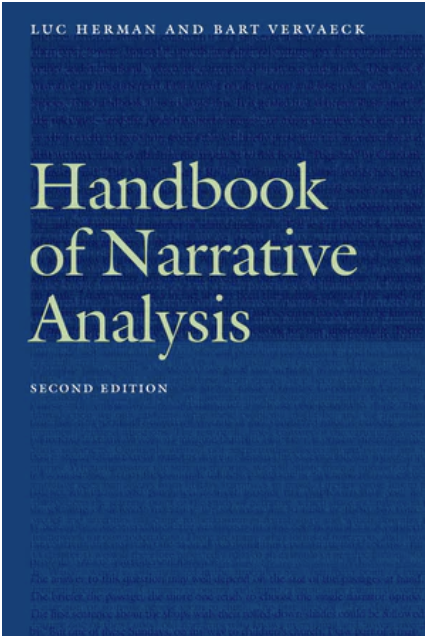
Luc Herman, Bart Vervaeck
Handbook of Narrative Analysis (2nd éd.)
University of Nebraska Press
ISBN : 978-1-4962-1714-1
438 p.
40,00$
PRÉSENTATION
Stories are everywhere, from fiction across media to politics and personal identity. Handbook of Narrative Analysis sorts out both traditional and recent narrative theories, providing the necessary skills to interpret any story. In addition to discussing classical theorists, such as Gérard Genette, Mieke Bal, and Seymour Chatman, Handbook of Narrative Analysis presents precursors (such as E. M. Forster), related theorists (Franz Stanzel, Dorrit Cohn), and a large variety of postclassical critics. Among the latter particular attention is paid to rhetorical, cognitive, and cultural approaches; intermediality; storyworlds; gender theory; and natural and unnatural narratology.
Not content to consider theory as an end in itself, Luc Herman and Bart Vervaeck use two short stories and a graphic narrative by contemporary authors as touchstones to illustrate each approach to narrative. In doing so they illuminate the practical implications of theoretical preferences and the ideological leanings underlying them. Marginal glosses guide the reader through discussions of theoretical issues, and an extensive bibliography points readers to the most current publications in the field. Written in an accessible style, this handbook combines a comprehensive treatment of its subject with a user-friendly format appropriate for specialists and nonspecialists alike.
Handbook of Narrative Analysis is the go-to book for understanding and interpreting narrative. This new edition revises and extends the first edition to describe and apply the last fifteen years of cutting-edge scholarship in the field of narrative theory.
Luc Herman is a professor of American literature and narrative theory at the University of Antwerp. He is the coauthor and coeditor of books on Thomas Pynchon and is the coeditor with Bart Vervaeck, Lars Bernaerts, and Dirk De Geest of Stories and Minds: Cognitive Approaches to Literary Narrative (Nebraska, 2013). Bart Vervaeck is a professor of Dutch literature and narrative theory at the University of Leuven. He is the author of monographs on postmodern fiction and on literary descents into hell.
SOMMAIRE
Introduction
1. Traditional Questions
2. New Questions
Chapter 1. Before and Surrounding Structuralism
1. Story and Plot
2. Telling and Showing
3. Author and Narrator
4. Narrator and Reader
5. Consciousness and Speech
6. Perception and Speech
Chapter 2. Structuralism
1. Story
1.1. Events
1.2. Actants
1.3. Setting
2. Narrative
2.1. Time
2.2. Character
2.3. Focalization
3. Narration
3.1. Narrating
3.2. Consciousness Representation
Chapter 3. Postclassical Narratology
1. Broadening Conceptions of the Narrative Text
1.1. Broadening the Medium: Intermedial Narratology
1.2. Broadening in Time: Diachronic Narratology
1.3. Broadening the Fictional World
2. Communicative Approaches
2.1. Rhetorical Narratology
2.2. Cognitive Narratology
3. Narratology and Ideology
3.1. Narrative Ethics
3.2. Feminist and Queer Narratology
3.3. Postcolonial Narratology
3.4. Cultural Narratology and Socio-narratology
3.4.1. Socio-narratology
3.4.2. Cultural Narratology
4. Everyday Life as a Narrative Process
4.1. Postmodern Narratology
4.2. Natural Narratology
4.3. Unnatural Narratology